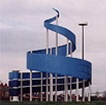As early as 1627 silk was woven in Coventry and by the end of the 1600s silk weaving was an important industry in the city. While silk weaving became important the traditional woollen textile industry of Coventry declined due to changes in fashion and competition from other countries.
Coventry became the centre of silk ribbon weaving in England from around 1700 until the middle of the 20th century. For many years it was the main industry in Coventry, employing thousands of people. The Herbert has a large and nationally important collection relating to ribbon weaving. The collection includes a jacquard loom, which stands in the entrance foyer, a hand loom, over 200 sample books, several thousand ribbons and a unique collection of woven silk pictures and bookmarks.
Cash’s of Coventry, were considered one of the UK’s quality weavers and produced silk ribbons which were very fashionable and were used to decorate dresses. The ribbons were a sign of wealth. The Herbert Art gallery’s large collection of ribbon samples show the complicated patterns that could be woven. There is an example of a jacquard loom in the museum. It used a series of punched holes on strips of card to create and control the woven patterns. It is an early example of a computer. (Early computers were programmed using punch cards before the use of transistors and more recently micro-chips.) You can see samples from The Herbert’s collection of ribbon samples and a picture of the Jacquard loom here
 The Blue Ribbon roundabout on the Foleshill/Phoenix Way roundabout is a reference to the importance of the silk ribbon weaving industry in Coventry.
The Blue Ribbon roundabout on the Foleshill/Phoenix Way roundabout is a reference to the importance of the silk ribbon weaving industry in Coventry.
